Trish Santoro is the woman behind wellwornfork.com - a site…
Restaurant menus are loaded with terms, ingredients, and preparations that are unfamiliar to even the seasoned diner. Brush up on common unknown words so you can easily decode a menu or cookbook.
By Trish Santoro
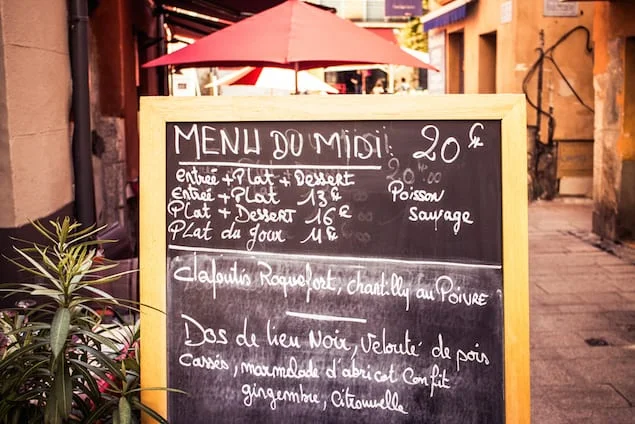 Shutterstock: funkyfrogstock
Shutterstock: funkyfrogstock
You’re sitting at a fancy restaurant and the hostess hands you the menu. You feel like you’re taking the SATs again and forgot to study. What do all these weird words mean?! Asking your server to define half of the menu for you seems embarrassing (and honestly, they don’t always have the right answers).
Worry no more! Brush up on these 63 fancy restaurant menu terms so you are in the know next time you go out to eat.
Aioli (vs. mayonnaise)
Most restaurants these days are using aioli as a fancy term for mayonnaise, but they’re supposed to be slightly different. Aioli, traditionally, begins with a paste of garlic cloves in a mortar & pestle and then continues with an emulsion of egg yolk & oil.
Amuse-bouche
A one bite hors d’oeuvre, typically served for free before the start of your meal, intended to “amuse” the mouth.
Au jus
Literally, “with [it’s own] juice”. Meaning, a sauce made up of the juice of the meat in your dish.
Baste
A technique where fat/drippings from the pan are poured over top of the food to develop the flavor.
Béarnaise
A version of hollandaise sauce with the addition of tarragon.
Bisque
A rich, creamy, smooth soup usually made with crustaceans. Traditionally, the shells of the crustaceans are sautéed and then ground into a fine paste to thicken the soup.
Braised
A technique of cooking in which the meat is seared on high-heat and then cooked in liquid for several hours until it becomes very tender and you can easily pull it apart.
Burrata
A fresh Italian cheese made of mozzarella and cream.
Canapé
A one or two bite hors d’oeuvre served on a some type of bread, cracker, or pastry.
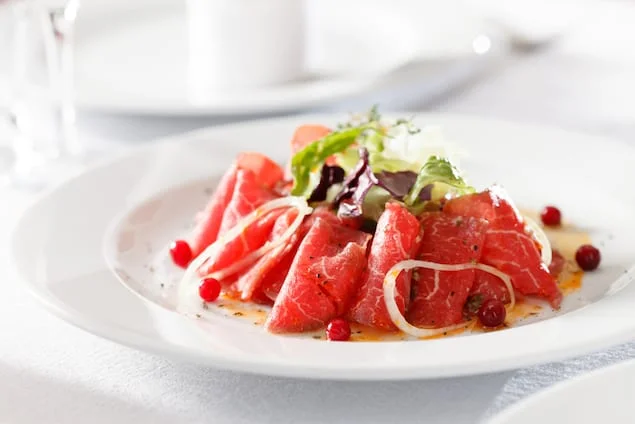 Shutterstock: Shebeko
Shutterstock: Shebeko
Carpaccio
An Italian dish made with raw beef, sliced or pounded extremely thin.
Cassoulet
A rich meat-and-white-bean stew originating from southern France.
Ceviche
A dish containing diced, raw fish that has been “cooked” with acid (typically citrus fruit).
Chèvre
French for goat cheese.
Chimichurri
A green sauce, mostly made of parsley & oil.
Cobia
A type of fish also referred to as “black salmon” even though it’s not in the salmon family.
Compote
Similar to a jam except whole pieces of fruit are cooked in sugar syrup.
Confit
A cooking technique in which the ingredient is poached in it’s own fat – at a much lower temperature than frying. Is also used when the food is cooked in any fat (not just it’s own) or even in sugar (for fruit).
Consommé
A type of perfectly clear soup made by combining ground meat, mirepoix, tomatoes and egg whites to remove any fat or sediment from the liquid and then discarded.
Cotija
A hard cow’s milk cheese that originated from Mexico.
Crudo
Italian for “raw”.
Daikon
A mild flavored radish.
Deconstructed
Meaning the components of the dish remain separate on the plate for presentation and to give you the experience of putting them back together however you choose (if you choose to do so).
Demi-glace
A sauce made of greatly reduced stock and (traditionally) thickened by roux. Although, it’s very common that the roux is left out.
Fine herbs
A combination of the following herbs chopped and mixed together: parsley, chives, tarragon, chervil.
Foie gras
Fattened duck or goose liver.
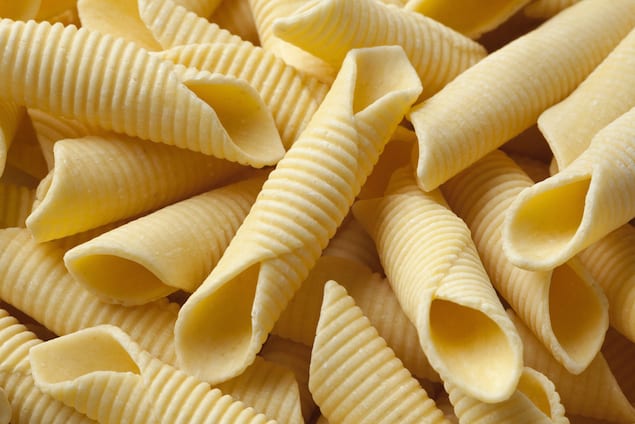 Shutterstock: picturepartners
Shutterstock: picturepartners
Garganelli
A type of pasta formed by rolling a flat square noodle into a tubular shape. Looks similar to penne.
Gastrique
A sauce (usually made to flavor other sauces) with equal parts caramelized sugar & vinegar.
Giardiniera
An Italian relish of pickled vegetables.
Granita
A semi-frozen dessert made from sugar, water, and flavorings.
Gremolada
Chopped herb (traditionally parsley) with lemon zest and garlic.
Hamachi
A Japanese amberjack fish very often served raw – sashimi style.
Kimchi
A spicy Korean side dish made of fermented vegetables (mostly cabbage). Very often added to dishes for extra spicy & sour flavor.
Kobe beef
A term that’s so over-used it doesn’t really mean anything anymore. It’s supposed to refer to meat from cattle that were raised in Japan according to very specific rules. Many restaurant menus name their beef “kobe” when it usually isn’t.
Lardon
A small strip of pork fat.
Maduros/Tostones
While both fried plantains, maduros are fried once while tostones are fried, smashed and then fried again. Maduros are also made with the ultra ripe (black) plantains so they turn out sweet. Tostones are usually made with the green plantains and end up more savory.
Maki/Nigiri/Sashimi
While all types of sushi, maki is rolled in seaweed with rice, vegetables, and (usually) raw fish. Nigiri is a piece or slice of your main ingredient on top of a clump of rice. Sashimi is a thin slice of raw fish or other ingredient.
Masala
A spice mix.
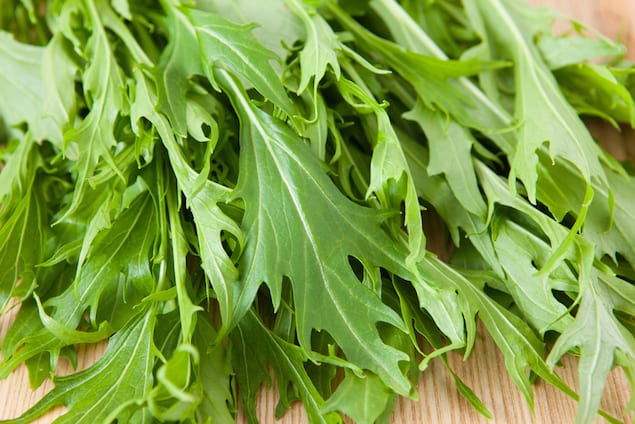 Shutterstock: yoshi0511
Shutterstock: yoshi0511
Mizuna
A Japanese lettuce in the mustard family.
Mole
A general name for a variety of Mexican sauces – most commonly made with chili peppers and chocolate.
Osso bucco
Braised veal shank.
Pâté/Terrine
Pâté is a smooth mixture of cooked meat & fat – sometimes cooked in a terrine mold. Terrine (the term) can be referred to both the oblong mold that shapes food inside of it or the finished product after cooking/chilling food in the mold.
Pistou
A French version of pesto that doesn’t contain pine nuts.
Pomodoro
A sauce made with tomatoes – typically served with pasta.
Pork belly
Just as it states. The belly of a pig. It could have been turned into bacon, but it wasn’t. So it’s just pork belly.
Ragout
An over-used term that has become hard to define. A well-seasoned stew that may contain meat or fish – with or without vegetables….or vegetables – with or without meat or fish.
Reduction
A sauce that has been simmered for quite some time to thicken (allow the water to evaporate) and develop in flavor.
Romanesco
A vegetable that looks like beautifully psychedelic broccoli.
Romesco
A nut and red pepper based sauce.
Saag
An Indian dish made of pureed greens and spices. Usually served with naan bread for dipping.
Sopressata
An Italian salami.
Sous-vide
A technique of cooking where food is vacuum-sealed in an airtight container and then placed in a temperature controlled water bath for long periods of time. The desired outcome is perfectly (evenly) cooked food.
Sunchoke
A Jerusalem artichoke.
Sweetbreads
Not to be confused with it’s name, sweetbreads are the thymus gland from a calf. Commonly breaded & fried.
Tandoori
A technique of cooking in a tandoor oven (made of clay and cylindrical).
Tartare
Finely chopped, raw meat or fish.
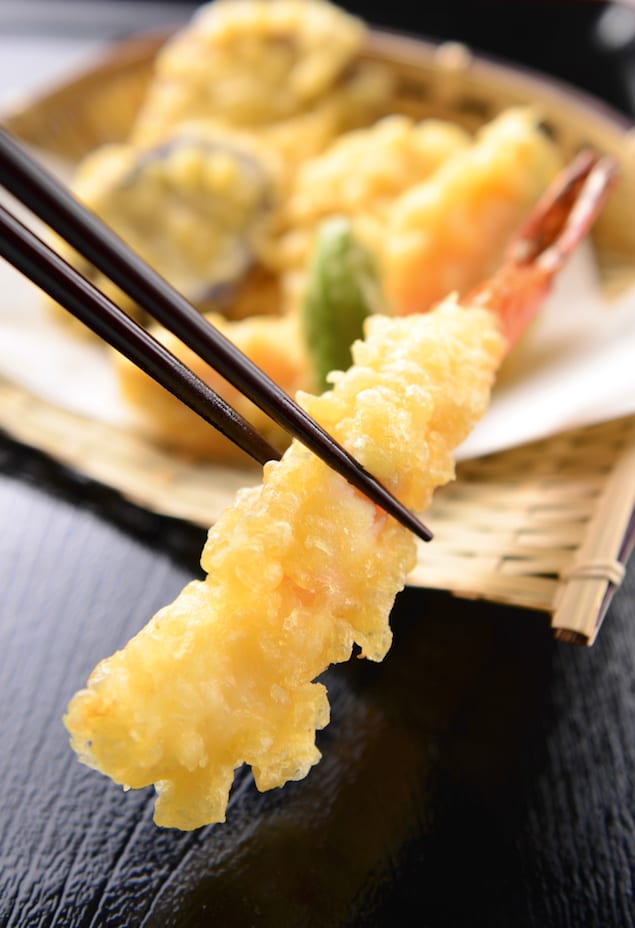 Shutterstock: abc7
Shutterstock: abc7
Tempura
A Japanese technique of cooking where the food is battered & fried.
Umami
An overly used term supposed to describe a fifth taste (sweet, sour, salty, bitter, and umami). It is a strong meaty taste imparted by glutamate and certain other amino acids.
Vindaloo
A spicy Indian curry dish.
Za’atar
A traditional eastern Mediterranean spice blend.
Of course, these 63 terms are not the ONLY ones you will come across in your fancy eating and cooking. The culinary world is always evolving and changing!
Trish Santoro is the woman behind wellwornfork.com - a site that teaches cooking techniques to improve your confidence in the kitchen. A Culinary Institute of America grad and adventurous eater, her food know-how is impressive, but her passion will always keep her learning more.




I loved this vocabulary, thanks!
Hi, I’m just looking at a fancy restaurant menu and an item has [MS 7-8] listed within the description.
What does this mean please?
I’m an event planner. Often I need to cater an event and want the menu card to have a sense of flair to it. Your list of words that define foods or sauces was very helpful
Additionally I am Heartsmart Ambassador for New York Presbytarian Hospital. I teach about heart health. I always have to share about food…what to eat, what to stay away from and how to prepare foods. This enlightened me as well for my teaching purposes when folks go out to eat to understand what certain words actually mean which describe how a dish was prepared.
Thank you